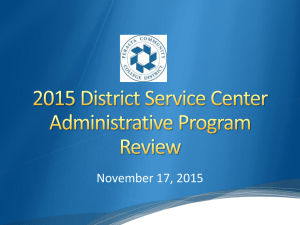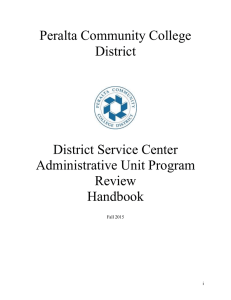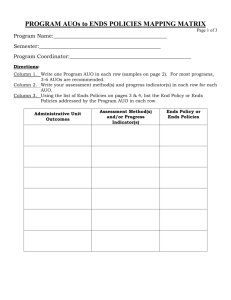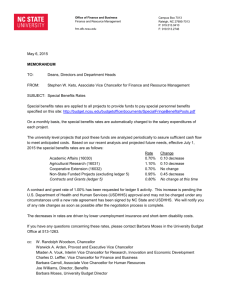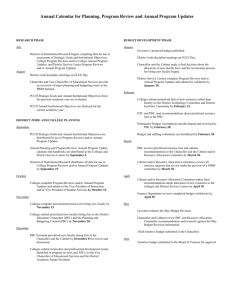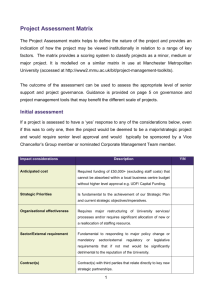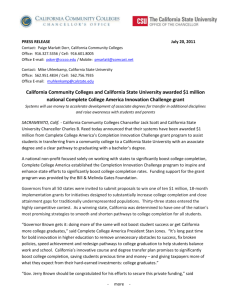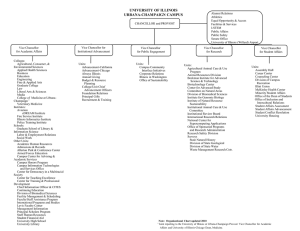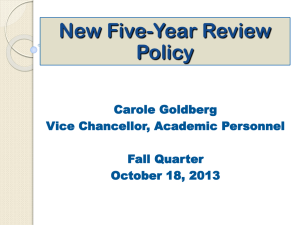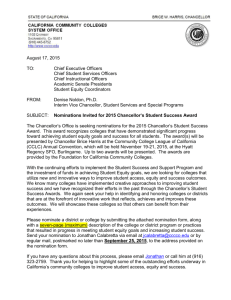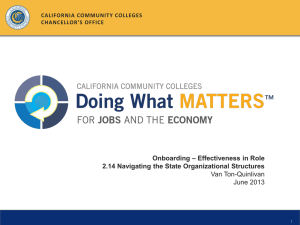2015 District Service Center Program Review
advertisement
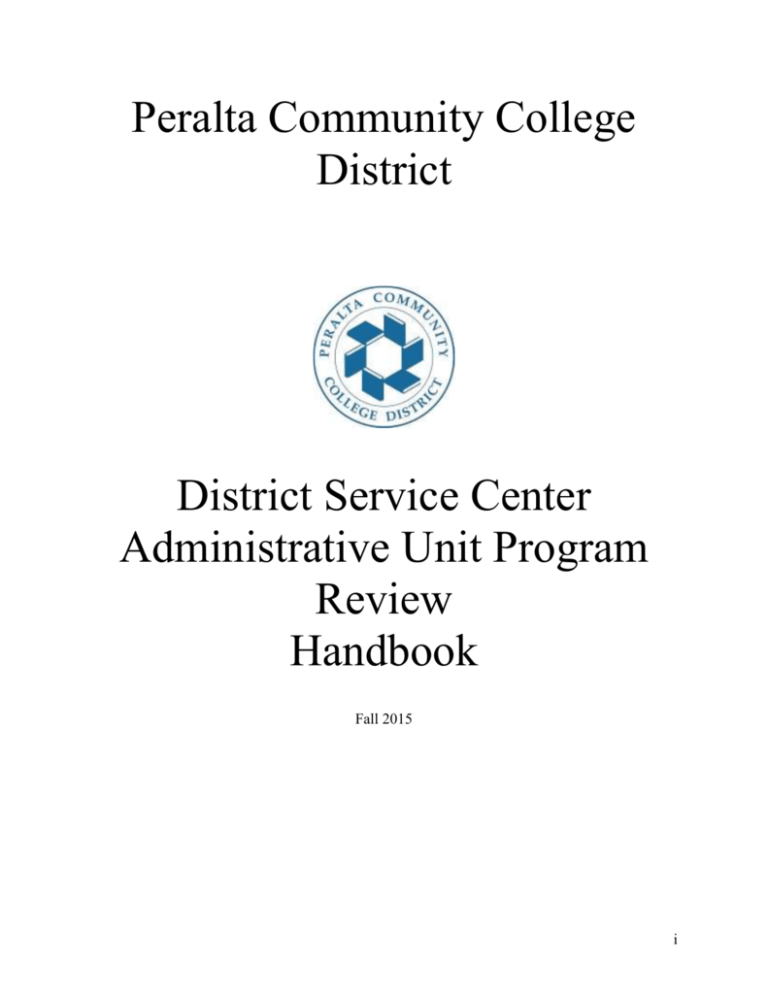
Peralta Community College District District Service Center Administrative Unit Program Review Handbook Fall 2015 i ii Table of Contents Purpose and Goals 1. Components in the Process 2. The District Service Center Administrative Unit Program Review Team 3. What are AUOs and PIOs? 4. Questions to Ask When Formulating AUOs and PIOs. 5. How do Administrative Unit Outcomes and Performance Improvement Objectives Fit Into the Institutional Effectiveness Process? 6. The District Service Center Administrative Unit Administrative Unit Program Review Report 7. Appendices Appendix A. The Legal and Professional Basis for Program Review Appendix B. Validation Form and Signatures 16. 17. iii Purpose and Goals The information gathered during the District Service Center Administrative Program Review process provides the basis for informed decision making in the Peralta Community College District. The District Service Center Administrative Program Review is a systematic process for the collection, analysis, and interpretation of data concerning District Service Center department or administrative unit, conducted every three years. It provides accountability by collecting, analyzing and disseminating information that will inform integrated planning, resource allocation, and decision-making processes. The primary goals are to: Ensure quality and excellence of administrative units at the District Office. Provide a standardized methodology for review of District Service Centers. Provide a mechanism for demonstrating continuous quality improvement, Provide a foundation for action that includes goal-setting and program improvement objectives. Sustain and improve the administrative unit’s effectiveness. Strengthen planning and decision-making. Identify resource needs. Inform integrated planning at all levels within the District. Ensure that District services reflect student needs, encourage student success, and foster support of the colleges Ensure that District services are aligned the District’s strategic goals and institutional objectives. Provide a baseline document for use as a reference for future annual program updates. 1 Components in the Process The District Service Center Administrative Unit Program Review process, which occurs every three years, consists of answering a set of questions designed to aid in the examination of administrative services. These questions direct attention to administrative functions, resource areas, and program improvement, in order to develop a plan that will improve the quality of administrative services provided to PCCD colleges and students. The primary components in the District Service Center Administrative Unit Program Review process include: The District Service Center Administrative Unit Program Review Team Completion of a District Service Center Administrative Unit Program Review Narrative Report every three years which includes statements of Administrative Unit Outcomes (AUOs) and Program Improvement Objectives PIOs). Validation of the District Service Center Administrative Program Review Report Annual Program Updates (APUs), which review progress in meeting the goals (Administrative Unit Outcomes and Program Improvement Objectives) identified in the District Service Center Administrative Program Review, are completed in the alternate years within the comprehensive Program Review three year- cycle. Thus, the recommendations and priorities from the District Service Center Administrative Unit Program Review feed directly into the development of administrative unit plans. In turn, the administrative unit plans serve as the driving mechanisms in formulation of updated District-wide educational, budget, technology and facilities plans. 2 The District Service Center Administrative Unit Program Review Team The District Service Center Administrative Unit Review Team is comprised of the following members: Administrative unit manager. Two additional staff members within the administrative unit. All staff within an administrative unit are encouraged to participate in the District Service Center Administrative Unit Program Review process, although participation is not mandatory. _____________________________________________________________________________ The District Service Center Program Review Team will: Develop Administrative Unit Outcomes (AUOs) and Program Improvement Objectives (PIOs) Analyze previous AUO assessment results and other information (needs assessments, satisfaction surveys , institutional effectiveness surveys, etc.) Complete the District Service Center Administrative Unit Program Review Narrative Report. ______________________________________________________________________________________ District Service Center Administrative Units that must complete Program Review are: Admissions and Records Childcare Centers Department of General Services Educational Services Financial Aid Finance General Counsel and Risk Management Human Resources Institutional Research International Education IT Public Information and Marketing ______________________________________________________________________________________ Validation: A validation committee, appointed by the Chancellor, comprised of faculty and administrators will review the District Service Center Administrative Unit Program Review Narrative Report to ensure completeness of the narrative report prior to submission to the Vice Chancellor of Educational Services and the Vice Chancellor of Finance. The validation committee will complete the validation form, included in Appendix B., and make recommendations for improvement, if necessary. 3 What are AUOs and PIOs? (Definitions) Administrative Unit Outcomes (AUOs): are measurable goals statements that express the expected benefit that an administrative unit hopes to achieve that is a result of the work that the unit performs in support of the colleges. This is a statement that describes what the administrative unit intends to accomplish. AUOs are connected to planning and demonstration of institutional effectiveness. Example: The Human Resources staff will provide training to all (100%) new hiring committee members in order to increase cultural and diversity awareness. Assessment: the process of measurement of an administrative unit outcome. Using an identified method of assessment, actual achievement will be determined by comparing the assessment results to the expected achievement (target). Assessment Methods: specific methods and/or tools used to gather information that tracks progress toward and/or achievement of an Administrative Unit Outcome (AUO) and Performance Improvement Objectives (PIOs). The assessment method must match the intended outcome. Methods may be direct or indirect. Direct methods are quantitative. Indirect methods are qualitative. Self-evaluation and institutional effectiveness surveys can provide data. Self- assessments must include documentation of successful completion of events and/or measures of attainment that provide content and/or performance standards appropriate to the administrative unit. Examples: Direct assessment – timeline is met for implementing the cultural and diversity awareness training for new hiring committee members and the number of participants is tracked by human resources staff. Indirect assessment – hiring committee members self-report their participation in cultural and diversity awareness trainings. Performance Improvement Objectives (PIOs): indicates what activities will be completed in support of the Administrative Unit Outcome. Performance Improvement Objectives are specific and advance the administrative unit in achieving the Administrative Unit Outcomes. These are statements that describe how the administrative unit will achieve the intended outcome. Examples: 1. A cultural and diversity awareness training program for new hiring committee members will be developed and implemented by January 1st. 2. Human Resources staff will maintain a record of the individuals that have completed cultural and diversity awareness training. 4 Questions to Ask When Formulating AUOs and PIOs Is the desired administrative unit outcome measureable? Is the desired administrative unit outcome directly related to the work of the administrative unit? What is the benefit to the recipient of the service provided by the administrative unit? How will the administrative unit measure achievement of the desired outcome? What are the assessment methods? When will the outcome be completed? What is the timeframe? What are the performance improvement objectives (activities) necessary to achieve the administrative unit outcome? What is the administrative unit’s process for using assessment results to improve future performance? What types of performance criteria indicate a successful outcome? What was the target or benchmark you hoped to achieve realistic? Was it met? What are your strategies for ongoing performance improvement? Are the administrative unit outcomes aligned with the PCCD Strategic Goals and Institutional Objectives? Does each administrative unit outcome have at least two performance improvement objectives? Why is this important? Do the administrative unit outcomes and performance improvement objective contain active verbs? Are necessary resources available to get the job done? __________________________________________________________________________________________ 5 How do AUOs and PIOs Fit into the Institutional Effectiveness Process? PCCD Institutional Mission PCCD Strategic Goals and Institutional Objectives Administrative Unit Mission Statement Administrative Unit Outcomes (AUOs) Use of Results for Planning and Resource Allocation Assessment of AUOs and PIOs Program Improvement Objectives (PIOs) PCCD Institutional Mission 6 The District Service Center Administrative Unit Program Review Report 1. Department or Administrative Unit: Date: Members of the Administrative Unit Program Review Team: ______________________________________________________________________________ 2. Administrative Unit Mission Statement: Please provide a mission statement or a brief description of the unit’s purpose stated in broad terms. It should reference how the work of the unit supports aspects on the District’s mission. It should also include how the colleges benefit from the work of the unit. If you do not already have an administrative unit mission statement, the following is a way of organizing the components, although they do not have to be presented in this order. “The mission of (name of your administrative unit) is to (primary purpose) by providing (primary functions or activities) to the colleges. These (services, functions, etc.) contribute to the District’s (mission, strategic goals, etc.) by (describe how).” ______________________________________________________________________________ 3. Organizational Chart: Please insert an organizational chart showing where the administrative unit is located within the District’s organizational structure. ____________________________________________________________________________ 7 4. District Service Center Administrative Unit Delineation of Functions: Please describe the primary functions of your administrative unit as they relate to District-wide operations and the goals of the colleges. Include the relationship and engagement with other District Service Centers and/or administrative units, the services that are provided to the colleges versus the District Office, and the effect these relationships have on the ability of the administrative unit to meet its previous goals and objectives. Functional Area or Done in Collaboration Name and Description With (leave blank if this function is not in of Primary Service collaboration with another District Service Center or Administrative Unit) Services Provided to the Colleges (describe all services provided to the colleges and indicate whether the service is centralized or decentralized. Comments 1. 2. 3. 4. 5. 6. 7. 8. 9. 10. 8 5. Major Accomplishments in the Past Three Years (Since the Completion of the Previous District Service Center Administrative Review): Please describe five – ten major accomplishments since completion of the previous District Service Center Administrative Review. Do not include normal ongoing operations. Please include start dates and when the accomplishment was finalized and/or implemented. Also, indicate the functional area and how these accomplishments have impacted the colleges. Additionally, indicate which of the PCCD Strategic Goals and Institutional Objectives the accomplishment supports. Major Accomplishment Start and End Date Functional Area Impact to the Colleges PCCD Strategic Goal PCCD Institutional Objective 9 6. Assessment: Which administrative unit outcomes (AUOs) did you assess in the past three years? What were the results? Please describe the assessment methods that were used. How this led to program improvement and the development of new administrative unit outcomes (AUOs) and program improvement objectives (PIOs)? Please fill in the table below. Administrative Unit Outcomes Program Improvement Objectives Functional Area Assessment Methods Assessment Results How did you Use the Results to Make Improvements? 2014-15: 2013-14: 2012-13: What do members of your administrative unit do to ensure that meaningful dialogue takes place in both the development of and assessment of the administrative unit outcomes and program improvement objectives? How do you know that your administrative unit is effective? What are the indicators that measure your effectiveness? What are the expected results of these indicators? Please describe the results of any surveys or focus groups that included evaluation and/or input about the effectiveness of the services provided by your administrative unit. 10 7. Administrative Unit Outcomes and Program Improvement Objectives for the Next Three Years: Please state the Administrative Unit Outcome (AUO) for the next three years for each of the functional areas you identified in section four of this report. Each AUO must be supported by one or more Program Improvement Objectives. An Administrative Unit Outcome states what the administrative unit intends to accomplish in the next three years. A Performance Improvement Objective indicates the activities that will be completed in support of the AUO. Performance Improvement Objectives are specific tasks and activities. Statements that start with “continue to” or “maintain” are not AUOs or PIOs. Functional Area (Description of Primary Service Identified in section 4.) 1. Administrative Unit Outcome (AUO) Performance Improvement Objectives (PIO)s (one or more per AUO) 1. 2. 2. 1. 2. 3. 1. 2. 4. 1. 2. 5. 1. 2. 6. 1. 2. 7. 1. 2. 8. 1. 2. 11 8. Human Resource Needs: Describe your level of staffing for the past four years in terms of FTE. Position 2012-2013 2013-2014 2014-2015 2015-2016 Administration Classified FT Classified PT Hourly Student Workers Faculty Reassigned Total FTE What are your anticipated staffing needs for the next three years? Why? Do you anticipate an increase in the workload of your administrative unit? Are additional staff necessary in order to achieve the program improvement objectives listed in section six of this report? Please provide a reason and/or evidence to support your request for additional staff and indicate which administrative unit outcome and program improvement objectives the request supports and prioritize the personnel requests. Position (indicate job classification) New or Replacement? Administrative Unit Outcome Program Improvement Objective (s) Reason and/or Evidence of the Need 1. 2. 3. 4., etc. 12 9. Equipment and Technology Needs (not covered by current budget): What are your key equipment and technological needs for the next three years? Why? Please provide a reason and/or evidence to support your requests and indicate which administrative unit outcome and program improvement objectives the request supports. Place items on the list in order (rank) of importance. If equipment needs are specific to a position, please indicate the linkage. Equipment or Technology Request New or Replacement? Administrative Unit Outcome Program Improvement Objective (s) Reason and/or Evidence of the Need 1. 2. 3. 4., etc. 10. Facility Needs (not covered by current building or remodeling projects): What are your new facilities needs for the next three years? Why? Please provide a reason and/or evidence to support your requests and indicate which administrative unit outcome and program improvement objectives the request supports. Place items on the list in order (rank) of importance. Facility Request Administrative Unit Outcome Program Improvement Objective (s) Reason and/or Evidence of the Need 1. 2. 3. 4., etc. 13 11. Professional and Organizational Development Needs (not covered by current budget): Please describe the professional development needs of the administrative unit. Include specifics such as training in the use of technology, cultural sensitivity, mentoring, and activities that help individuals stay current with their job responsibilities or to meet state, federal or professional requirements, etc. Place items on the list in order of rank or importance and indicate which administrative unit outcome and program improvement objectives the request supports. Professional or Organizational Development Request Administrative Unit Outcome Program Improvement Objective (s) Reason and/or Evidence of the Need Estimated Cost 1. 2. 3. 4., etc. 12. Other Needs (not covered by current budget): Please describe any other needs that you are certain do not fit elsewhere. Not all needs will have a direct cost, but may require reallocation of current staff time. Place items on the list in order of rank or importance and indicate which administrative unit outcome and program improvement objectives the request supports. Other Needs Administrative Unit Outcome Program Improvement Objective (s) Reason and/or Evidence of the Need Estimated Cost 1. 2. 3. 4., etc. 14 Appendices 15 Appendix A. The Legal and Professional Basis for Program Review TITLE 5, Section 51022(a) The governing board of each community college district shall, no later than July1, 1984, develop, file with the Chancellor, and carry out its policies for the establishment, modification, or discontinuance of courses or programs. Such policies shall incorporate statutory responsibilities regarding vocational or occupational training program review as specified in section 78016 of the Education Code. ACCJC STANDARDS Standard 1B. Improving Institutional Effectiveness The institution demonstrates a conscious effort to produce and support student learning, measures that learning, assesses how well learning is occurring, and makes changes to improve student learning. The institution also organizes its key processes and allocates its resources to effectively support student learning. The institution demonstrates its effectiveness by providing 1) evidence of the achievement of student learning outcomes and 2) evidence of institution and program performance. The institution uses ongoing and systematic evaluation and planning to refine its key processes and improve student learning. 1. The institution maintains an ongoing, collegial, self-reflective dialogue about the continuous improvement of student learning and institutional processes. 2. The institution sets goals to improve its effectiveness consistent with its stated purposes. The institution articulates its goals and states the objectives derived from them in measurable terms so that the degree to which they are achieved can be determined and widely discussed. The institutional members understand these goals and work collaboratively toward their achievement. 3. The institution assesses progress toward achieving its stated goals and makes decisions regarding the improvement of institutional effectiveness in an ongoing and systematic cycle of evaluation, integrated planning, resource allocation, implementation, and reevaluation. Evaluation is based on analyses of both quantitative and qualitative data. 4. The institution provides evidence that the planning process is broad-based, offers opportunities for input by appropriate constituencies, allocates necessary resources, and leads to improvement of institutional effectiveness. 5. The institution uses documented assessment results to communicate matters of quality assurance to appropriate constituencies. 6. The institution assures the effectiveness of its ongoing planning and resource allocation processes by systematically reviewing and modifying, as appropriate, all parts of the cycle, including institutional and other research efforts. 7. The institution assesses its evaluation mechanisms through a systematic review of their effectiveness in improving instructional programs, student support services, and library and other learning support services. EDUCATION CODE, Section 78016 (a) Every vocational or occupational training program offered by a community college district shall be reviewed every two years by the governing board of the district to ensure that each program, as demonstrated by the California Occupational Information System, including the State-Local Cooperative Labor Market Information Program established in Section 10533 of the Unemployment Insurance code, or if this program is not available in the labor market area, other available sources of labor market information, does all of the following: (1) Meets a documented labor market demand. (2) Does not represent unnecessary duplication of other manpower training programs in the area. (3) Is of demonstrated effectiveness as measured by the employment and completion success of its students. (b) Any program that does not meet the requirements of subdivision (a) and the standards promulgated by the governing board shall be terminated within one year. (c) The review process required by this section shall include the review and comments by the local Private Industry Council established pursuant to Division 8 (commencing with Section 15000) of the Unemployment Insurance Code, which review and comments shall occur prior to any decision by the appropriate governing body. 16 Appendix B. Program Review Validation Form and Signature Page Department or Administrative Unit: Part I. Overall Assessment of the Program Review Report Review Criteria Comments: Explanation if the box is not checked 1. All sections of the program review narrative report are addressed. 2. Delineation of functions includes areas that provide service to the Colleges. 3. Administrative Unit Outcomes (AUOs) are clearly stated and reflect the work of the administrative unit. 4. Program Improvement Objectives (PIOs) support each Administrative Unit Outcome (AUO). 5. The resource requests are connected to the Administrative Unit Outcomes (AUOs) and Program Improvement Objectives (PIOs) and are aligned to the PCCD Strategic Goals and Institutional Objectives. 17 Part II. Choose one of the Ratings Below and Follow the Instructions. Rating Instructions for First Review 1. Accepted. 1. Complete the signatures below and submit to the Vice Chancellor of Educational Services and the Vice Chancellor of Finance. 2. Conditionally Accepted. 2. Provide commentary that indicates areas in the report that require improvement and return the report to the administrative unit manager with a timeline for resubmission to the validation chair. 3. Not Accepted. 3. Provide commentary that indicates areas in the report that require completion and/or revision and return the report to the administrative unit manager with instructions to revise. Notify the Vice Chancellor of Educational Services, the Vice Chancellor of Finance of the Not Accepted status. Rating Instructions for Second Review (if necessary) 1. Accepted. 1. Complete the signatures below and submit to the Vice Chancellor of Educational Services and the Vice Chancellor of Finance. 2. Conditionally Accepted. 2. Provide commentary that indicates areas in the report that require improvement and return the report to the administrative unit manager with a timeline for final resubmission to the validation chair. 3. Not Accepted. 3. Provide commentary that indicates areas in the report that require completion and/or revision and return the report to the administrative unit manager with instructions to revise. Notify the Vice Chancellor of Educational Services, the Vice Chancellor of Finance and the Chancellor of the Not Accepted status. 18 Part III. Signatures Validation Committee Chair ___________________________ Print Name _________________________________________ Signature _________________ Date Validation Committee Members ___________________________ _________________________________________ Print Name Signature _________________ Date Validation Committee Members ___________________________ _________________________________________ Print Name Signature _________________ Date Validation Committee Members ___________________________ _________________________________________ Print Name Signature _________________ Date Validation Committee Members ___________________________ _________________________________________ Print Name Signature _________________ Date __________________________________________________________________________________________ Received by Vice Chancellor of Educational Services ___________________________ _________________________________________ Print Name Signature _________________ Date Received by Vice Chancellor of Finance ___________________________ _________________________________________ Print Name Signature _________________ Date 19 20
